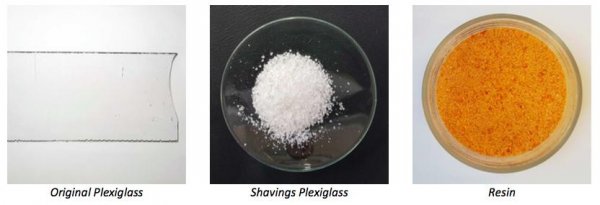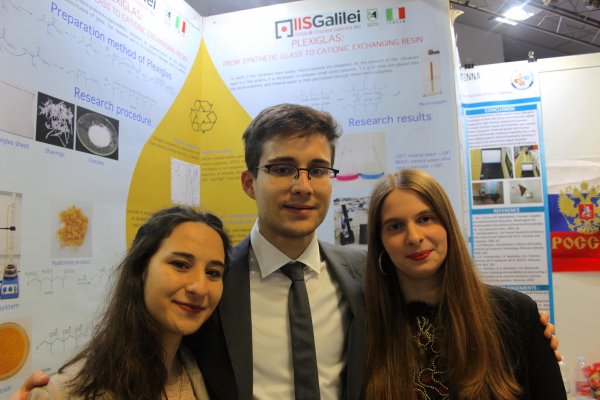Exhibitors 2018
- HOME AUTOMATION
- ROBOTICS
- YOUNG MAKERS (< 18)
- OPEN SOURCE
- 3D PRINTING
- DRONES
- EDUCATION
- FABRICATION
- HACKS
- NEW MANUFACTURING
- SCIENCE
- ENERGY & SUSTAINABILITY
- ART
- INTERNET OF THINGS
- MUSIC & SOUND
- RECYCLING & UPCYCLING
- KIDS & EDUCATION
- ARTISANS & NEW CRAFT
- CULTURAL HERITAGE
- GAMES
- WELLNESS & HEALTHCARE
- FASHION & WEARABLES
- FOOD & AGRICULTURE
- BIOLOGY
- 3D SCANNING
- AEROSPACE
- STEAM PUNK
- ARTIFICIAL INTELLIGENCE
- ARDUINO
- CROWDFUNDING
Plexiglas
Plexiglas is a macromolecule (poly-methyl-methacrylate) obtained by polymerization of the Methyl Methacrylate while cation exchanging resins have acidic groups such as –COOH (carboxyl; weak resin) and – SO3H (sulfonic; strong resin) which fix metallic cations dissolved in water releasing an equivalent of protons through the following reaction:
2 RCOOH + Me2+ (RCOO)2Me + 2 H+
Regeneration is made treating the exhausted resin with diluted hydrochloric acid (HCl) which moves the equilibrium to the left. The aim of our research is to re-use the discarded Plexiglas by transforming it into a cationic exchanging resin. Alkaline hydrolysis transforms the –COOCH3 group into –COO(–) group; the obtained group is then transformed into –COOH group by means of a treatment with HCl. A sample of transparent and colourless Plexiglas is prepared by drilling sheets of this material, 3 mm and 6 mm thick. The Plexiglas shavings are reduced in size using a blender. The obtained sample is used both to record IR spectra and alkaline hydrolysis reaction. The first experiment is carried out with 0.5 g of Plexiglas and 35 mL of KOH solution (8.5 % m/V). The solvent is anhydrous ethanol. The mixture is placed into a single–neck flat–bottom flask (250 mL) at reflux temperature of 82 °C for 6 hours. The second experiment is carried out with 10 g of Plexiglas and 100 mL of NaOH solution (10 % m/V). The solvent is anhydrous ethanol. The mixture is placed into a single–neck flat–bottom flask (250 mL) at reflux temperature of 84°C for 65 hours. When hydrolysis is finished, the solid part settles and is taken away from the solution. It is then rinsed with alkaline anhydrous ethanol (pH ≈ 7–8) and after that with only anhydrous ethanol. The solid is naturally dried and a small amount of it is used to record IR spectra.
The dried solid is treated with diluted HCl (50 HCl: 50 H2O) for some days. After the acidic treatment the solid is removed from the solution and rinsed with de–ionized water (pH ≈ 6–7) until chloride ions are taken away and it is naturally dried. IR spectra of the solid are recorded. The remaining solid is used to prepare micro–columns.
After the alkaline hydrolysis spectra of the solid show the characteristic band of the asymmetric stretching of the –COO(–) (1610–1550) at 1567 (1st experiment) and at 1555 (2nd experiment). Instead after the acidic treatment the spectra of the solid show that this band has disappeared. On the contrary the characteristic band of the OH stretching of the –COOH group (3300–2500) at 3228 (1st experiment) and at 3200 (2nd experiment) appears.
The water hardness, due to Ca2+ and Mg2+ ions, is studied to verify the capability of the obtained resin to capture these cations. For this purpose, some mineral water is percolated through the micro–columns. There are three experimental evidences to validate the hypothesis:
EDTA molecule (Ethylene Di–amine Tetra–Acetic acid, disodium salt) to estimate hardness is not required.
The pH of the percolated water through the column decreases from 8 of the mineral water without any treatment, to 6.3 after percolation through resin, as expected.
The spectrum recorded in the visible range of the percolated mineral water through the column plus EBT (Eriochrome Black T) indicator is the same as the spectrum obtained using de–ionized water plus the same amount of EBT indicator.
In conclusion, the research has provided evidence that it is possible to convert Plexiglas into cationic exchanging resin.
2 RCOOH + Me2+ (RCOO)2Me + 2 H+
Regeneration is made treating the exhausted resin with diluted hydrochloric acid (HCl) which moves the equilibrium to the left. The aim of our research is to re-use the discarded Plexiglas by transforming it into a cationic exchanging resin. Alkaline hydrolysis transforms the –COOCH3 group into –COO(–) group; the obtained group is then transformed into –COOH group by means of a treatment with HCl. A sample of transparent and colourless Plexiglas is prepared by drilling sheets of this material, 3 mm and 6 mm thick. The Plexiglas shavings are reduced in size using a blender. The obtained sample is used both to record IR spectra and alkaline hydrolysis reaction. The first experiment is carried out with 0.5 g of Plexiglas and 35 mL of KOH solution (8.5 % m/V). The solvent is anhydrous ethanol. The mixture is placed into a single–neck flat–bottom flask (250 mL) at reflux temperature of 82 °C for 6 hours. The second experiment is carried out with 10 g of Plexiglas and 100 mL of NaOH solution (10 % m/V). The solvent is anhydrous ethanol. The mixture is placed into a single–neck flat–bottom flask (250 mL) at reflux temperature of 84°C for 65 hours. When hydrolysis is finished, the solid part settles and is taken away from the solution. It is then rinsed with alkaline anhydrous ethanol (pH ≈ 7–8) and after that with only anhydrous ethanol. The solid is naturally dried and a small amount of it is used to record IR spectra.
The dried solid is treated with diluted HCl (50 HCl: 50 H2O) for some days. After the acidic treatment the solid is removed from the solution and rinsed with de–ionized water (pH ≈ 6–7) until chloride ions are taken away and it is naturally dried. IR spectra of the solid are recorded. The remaining solid is used to prepare micro–columns.
After the alkaline hydrolysis spectra of the solid show the characteristic band of the asymmetric stretching of the –COO(–) (1610–1550) at 1567 (1st experiment) and at 1555 (2nd experiment). Instead after the acidic treatment the spectra of the solid show that this band has disappeared. On the contrary the characteristic band of the OH stretching of the –COOH group (3300–2500) at 3228 (1st experiment) and at 3200 (2nd experiment) appears.
The water hardness, due to Ca2+ and Mg2+ ions, is studied to verify the capability of the obtained resin to capture these cations. For this purpose, some mineral water is percolated through the micro–columns. There are three experimental evidences to validate the hypothesis:
EDTA molecule (Ethylene Di–amine Tetra–Acetic acid, disodium salt) to estimate hardness is not required.
The pH of the percolated water through the column decreases from 8 of the mineral water without any treatment, to 6.3 after percolation through resin, as expected.
The spectrum recorded in the visible range of the percolated mineral water through the column plus EBT (Eriochrome Black T) indicator is the same as the spectrum obtained using de–ionized water plus the same amount of EBT indicator.
In conclusion, the research has provided evidence that it is possible to convert Plexiglas into cationic exchanging resin.
Italy
Gruppo composto da Elisa Ausili, Noor Gholamhazrat Hojat, Lorenzo Soverchia, Istituto di Istruzione Superiore Galileo Galilei
We are a group of three people, Elisa Ausili, Noor Gholamhazrat Hojat and Lorenzo Soverchia. During the last school year of an environmental biotechnologies course, we worked for at least two afternoons per week on a scientific research that involved a new way of recycling Plexiglas. We decided to carry out this type of experimental research in our school laboratories because we strongly believe in circular economy fundaments.
B17 (pav. 9)




















































































